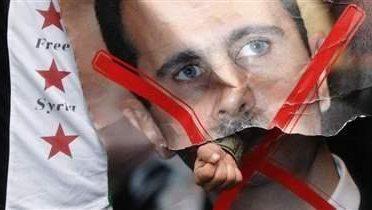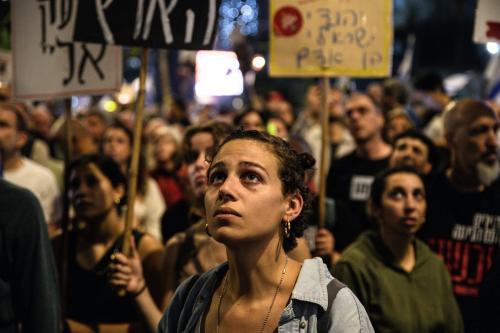Content from the Brookings Doha Center is now archived. In September 2021, after 14 years of impactful partnership, Brookings and the Brookings Doha Center announced that they were ending their affiliation. The Brookings Doha Center is now the Middle East Council on Global Affairs, a separate public policy institution based in Qatar.
Syria is trapped on a crumbling precipice,
and however it might fall will entail significant risks
for the United States and for the Syrian people.
The brutal regime of Bashar al-Asad is employing its
loyal military forces and sectarian thugs to crush the
opposition and reassert its tyranny. Even if Bashar
fails, Syria may not be out of the woods: an increasingly
likely alternative to the current regime is a
bloody civil war similar to what we saw in Lebanon,
Bosnia, Congo, and most recently in Iraq. The horrors
of such a war might even exceed the brutal reassertion
of Asad’s control, and would cause spillover
into Syria’s neighbors—Turkey, Iraq, Jordan, Lebanon,
and Israel—that could be disastrous for them
and for American interests in the Middle East.
But the unrest in Syria, which is now entering its second
year, also offers some important opportunities,
ones that would come from the fall of the regime of
Bashar al-Asad, whose family has ruled the country
with an iron grip for over forty years. Syria is Iran’s
oldest and most important ally in the Arab world, and
the Iranian regime has doubled down on Asad, providing
him with financial aid and military support to
shore up his regime. Asad’s departure would deal a significant
blow to Tehran, further isolating it at a time
when it has few friends in the region or the world. In
addition, Damascus is steadfast in its hostility toward
Israel, and Asad’s regime is also a longtime supporter
of terrorist groups like Hizballah and Hamas, and has
at times aided al-Qa’ida terrorists and former regime
elements in Iraq. The regime’s collapse, therefore,
could have significant benefits for the United States
and its allies in the region.
Actually ousting Asad, however, will not be easy. Although
the Obama administration has for months
called for Asad to go, every policy option to remove
him is flawed, and some could even make the situation
worse—seemingly a recipe for inaction. Doing
nothing, however, means standing by while Asad
murders his own people, and Syria plunges into civil
war and risks becoming a failed state. Already the violence
is staggering: as of March 2012, at least 8,000
Syrians have died and thousands more have been arrested
and tortured in trying to topple the regime. At
the same time, Syria is fragmenting. The Syrian opposition
remains divided, and the Free Syrian Army
is more a brand than a meaningful, unified force. Al-
Qa’ida is urging fighters to join the fray in Syria, and
sectarian killings and atrocities are growing. Should
the violence continue to intensify, Syria’s neighbors
may increase their meddling, and instability could
spread, further weakening already-fragile neighbors
like Iraq and Lebanon.
So to protect U.S. interests, Asad cannot triumph.
But a failed Syria, one wracked by civil war, would be
just as bad. Thus, U.S. policy must walk this tightrope,
trying to remove Asad, but doing so in a way
that keeps Syria an intact state capable of policing its
borders and ensuring order at home. At the end of
the day, however, removing Asad may not be doable
at a price the United States is willing to pay. If so, the
U.S. government may be forced to choose between
living with a brutal but weakened Asad or getting rid
of Asad regardless of the consequences.
This memo lays out six options for the United States
to consider to achieve Asad’s overthrow, should it
choose to do so:
- Removing the regime via diplomacy;
- Coercing the regime via sanctions and diplomatic
isolation; - Arming the Syrian opposition to overthrow
the regime; - Engaging in a Libya-like air campaign to
help an opposition army gain victory; - Invading Syria with U.S.-led forces and toppling
the regime directly; and - Participating in a multilateral, NATO-led effort
to oust Asad and rebuild Syria.
The options are complex, and policymakers will probably
try to combine several in an attempt to accentuate
the positives and minimize the negatives, which
will inevitably be difficult and bring out new complications.
But by focusing on discrete approaches, this
memo helps expose their relative strengths and weaknesses.
For each course of action, this memo describes
the strategy inherent to the option and what it would
entail in practice. It also assesses the option’s advantages
and disadvantages.
This memo does not endorse any particular policy option.
Rather, it seeks to explain the risks and benefits of
possible courses of action at this moment in time. As
conditions change, some options may become more
practical or desirable and others less so. The authors
mostly agree on the advantages and disadvantages
of each approach but weigh the relative rewards and
costs differently.






